Analyzing Diabetes Health Inequality in India: A Detailed Report
VerifiedAdded on 2021/05/31
|13
|3655
|112
Report
AI Summary
This report provides a comprehensive analysis of diabetes health inequalities in India. It explores the increasing prevalence of diabetes, highlighting the impact of genetic and environmental factors, including lifestyle changes, urbanization, and socio-economic disparities. The report examines historical explanations of diabetes inequalities, focusing on material, psychosocial, and behavioral factors. It discusses the role of social determinants of health, such as poverty, education, and access to healthcare, in shaping diabetes outcomes. The report reviews past and current public health models used to depict diabetes health inequality in India, focusing on social determinants. It also highlights government initiatives and interventions aimed at addressing these inequalities, including national programs for diabetes control and awareness campaigns. The report underscores the importance of understanding and addressing the complex interplay of factors contributing to diabetes health disparities in India.
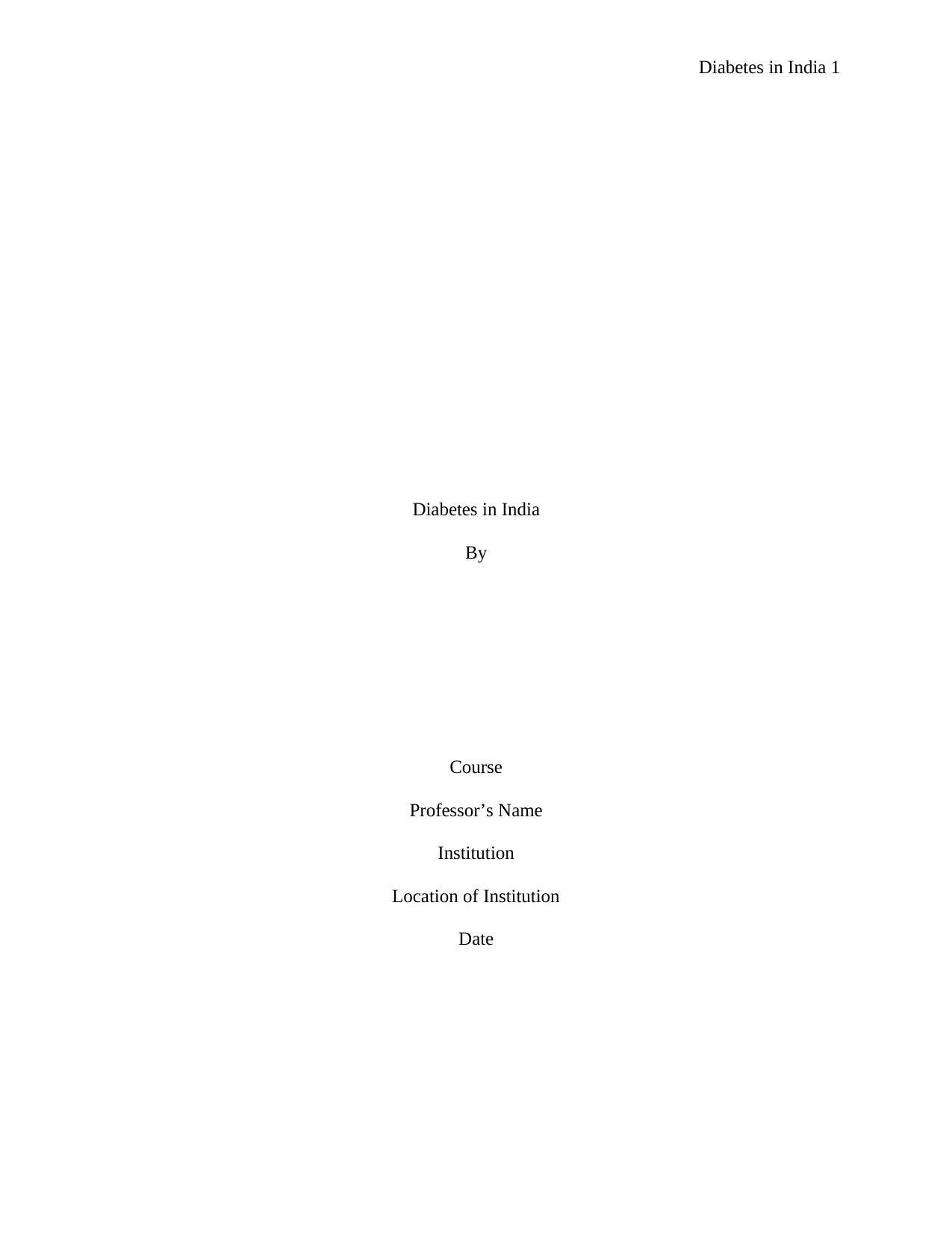
Diabetes in India 1
Diabetes in India
By
Course
Professor’s Name
Institution
Location of Institution
Date
Diabetes in India
By
Course
Professor’s Name
Institution
Location of Institution
Date
Paraphrase This Document
Need a fresh take? Get an instant paraphrase of this document with our AI Paraphraser
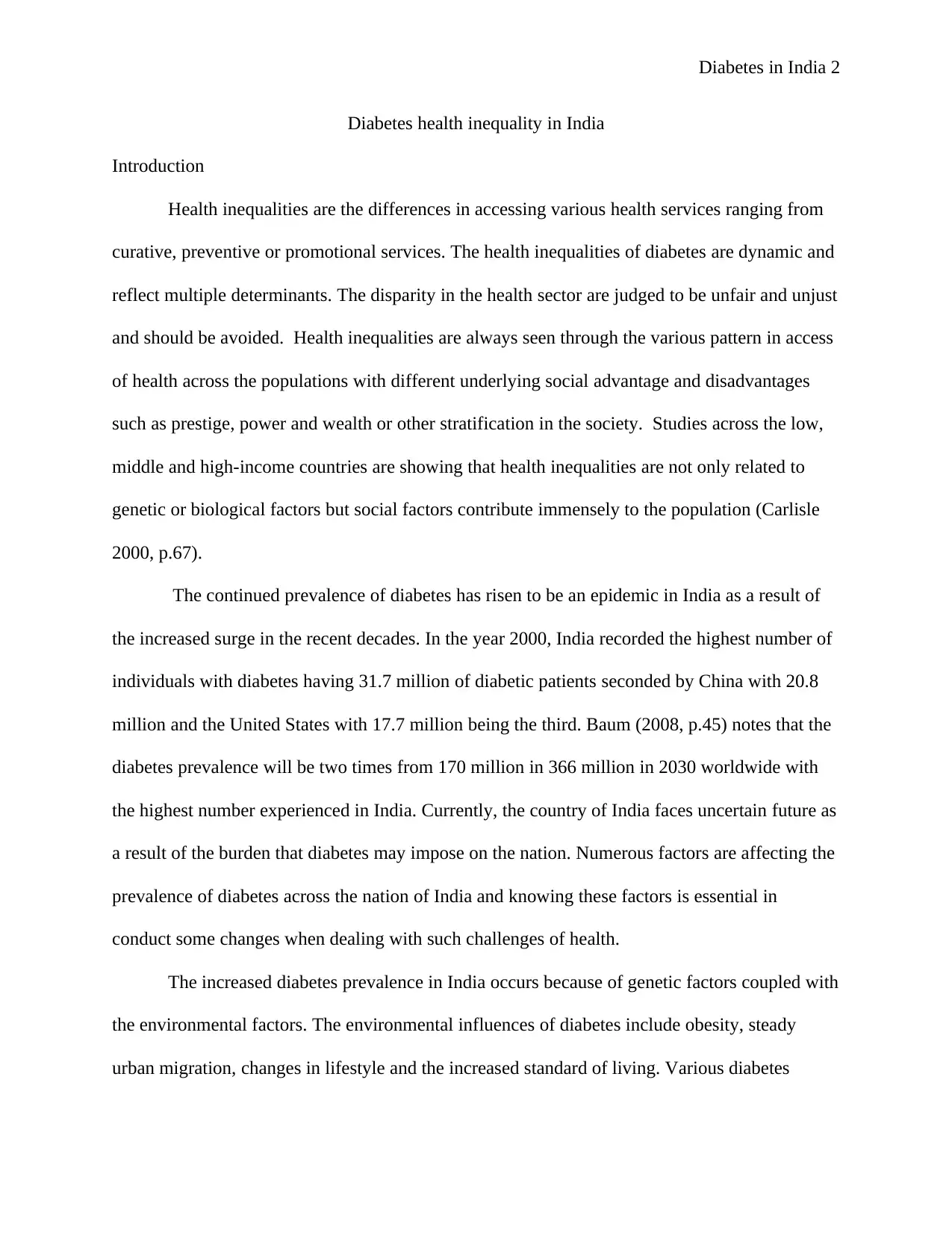
Diabetes in India 2
Diabetes health inequality in India
Introduction
Health inequalities are the differences in accessing various health services ranging from
curative, preventive or promotional services. The health inequalities of diabetes are dynamic and
reflect multiple determinants. The disparity in the health sector are judged to be unfair and unjust
and should be avoided. Health inequalities are always seen through the various pattern in access
of health across the populations with different underlying social advantage and disadvantages
such as prestige, power and wealth or other stratification in the society. Studies across the low,
middle and high-income countries are showing that health inequalities are not only related to
genetic or biological factors but social factors contribute immensely to the population (Carlisle
2000, p.67).
The continued prevalence of diabetes has risen to be an epidemic in India as a result of
the increased surge in the recent decades. In the year 2000, India recorded the highest number of
individuals with diabetes having 31.7 million of diabetic patients seconded by China with 20.8
million and the United States with 17.7 million being the third. Baum (2008, p.45) notes that the
diabetes prevalence will be two times from 170 million in 366 million in 2030 worldwide with
the highest number experienced in India. Currently, the country of India faces uncertain future as
a result of the burden that diabetes may impose on the nation. Numerous factors are affecting the
prevalence of diabetes across the nation of India and knowing these factors is essential in
conduct some changes when dealing with such challenges of health.
The increased diabetes prevalence in India occurs because of genetic factors coupled with
the environmental factors. The environmental influences of diabetes include obesity, steady
urban migration, changes in lifestyle and the increased standard of living. Various diabetes
Diabetes health inequality in India
Introduction
Health inequalities are the differences in accessing various health services ranging from
curative, preventive or promotional services. The health inequalities of diabetes are dynamic and
reflect multiple determinants. The disparity in the health sector are judged to be unfair and unjust
and should be avoided. Health inequalities are always seen through the various pattern in access
of health across the populations with different underlying social advantage and disadvantages
such as prestige, power and wealth or other stratification in the society. Studies across the low,
middle and high-income countries are showing that health inequalities are not only related to
genetic or biological factors but social factors contribute immensely to the population (Carlisle
2000, p.67).
The continued prevalence of diabetes has risen to be an epidemic in India as a result of
the increased surge in the recent decades. In the year 2000, India recorded the highest number of
individuals with diabetes having 31.7 million of diabetic patients seconded by China with 20.8
million and the United States with 17.7 million being the third. Baum (2008, p.45) notes that the
diabetes prevalence will be two times from 170 million in 366 million in 2030 worldwide with
the highest number experienced in India. Currently, the country of India faces uncertain future as
a result of the burden that diabetes may impose on the nation. Numerous factors are affecting the
prevalence of diabetes across the nation of India and knowing these factors is essential in
conduct some changes when dealing with such challenges of health.
The increased diabetes prevalence in India occurs because of genetic factors coupled with
the environmental factors. The environmental influences of diabetes include obesity, steady
urban migration, changes in lifestyle and the increased standard of living. Various diabetes
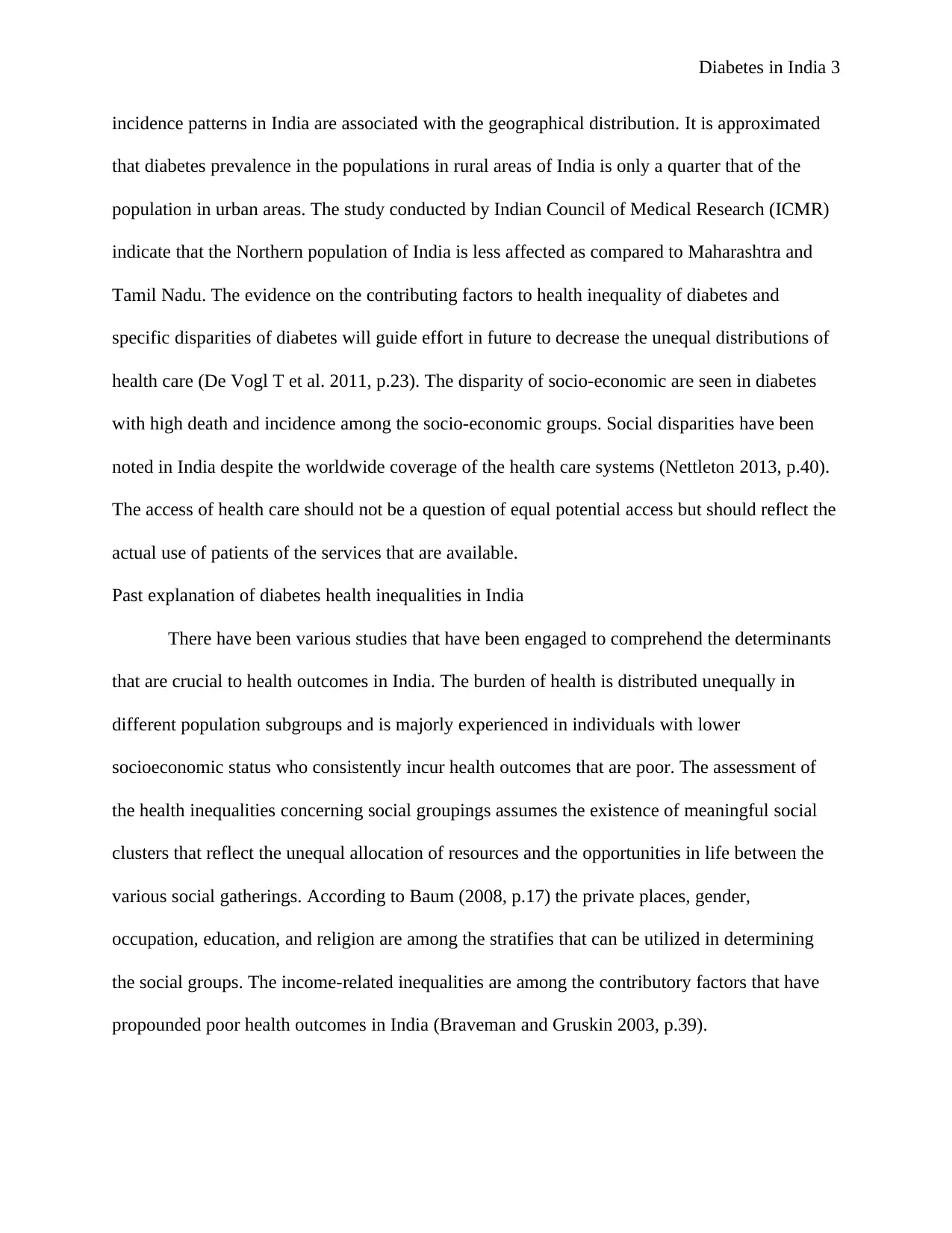
Diabetes in India 3
incidence patterns in India are associated with the geographical distribution. It is approximated
that diabetes prevalence in the populations in rural areas of India is only a quarter that of the
population in urban areas. The study conducted by Indian Council of Medical Research (ICMR)
indicate that the Northern population of India is less affected as compared to Maharashtra and
Tamil Nadu. The evidence on the contributing factors to health inequality of diabetes and
specific disparities of diabetes will guide effort in future to decrease the unequal distributions of
health care (De Vogl T et al. 2011, p.23). The disparity of socio-economic are seen in diabetes
with high death and incidence among the socio-economic groups. Social disparities have been
noted in India despite the worldwide coverage of the health care systems (Nettleton 2013, p.40).
The access of health care should not be a question of equal potential access but should reflect the
actual use of patients of the services that are available.
Past explanation of diabetes health inequalities in India
There have been various studies that have been engaged to comprehend the determinants
that are crucial to health outcomes in India. The burden of health is distributed unequally in
different population subgroups and is majorly experienced in individuals with lower
socioeconomic status who consistently incur health outcomes that are poor. The assessment of
the health inequalities concerning social groupings assumes the existence of meaningful social
clusters that reflect the unequal allocation of resources and the opportunities in life between the
various social gatherings. According to Baum (2008, p.17) the private places, gender,
occupation, education, and religion are among the stratifies that can be utilized in determining
the social groups. The income-related inequalities are among the contributory factors that have
propounded poor health outcomes in India (Braveman and Gruskin 2003, p.39).
incidence patterns in India are associated with the geographical distribution. It is approximated
that diabetes prevalence in the populations in rural areas of India is only a quarter that of the
population in urban areas. The study conducted by Indian Council of Medical Research (ICMR)
indicate that the Northern population of India is less affected as compared to Maharashtra and
Tamil Nadu. The evidence on the contributing factors to health inequality of diabetes and
specific disparities of diabetes will guide effort in future to decrease the unequal distributions of
health care (De Vogl T et al. 2011, p.23). The disparity of socio-economic are seen in diabetes
with high death and incidence among the socio-economic groups. Social disparities have been
noted in India despite the worldwide coverage of the health care systems (Nettleton 2013, p.40).
The access of health care should not be a question of equal potential access but should reflect the
actual use of patients of the services that are available.
Past explanation of diabetes health inequalities in India
There have been various studies that have been engaged to comprehend the determinants
that are crucial to health outcomes in India. The burden of health is distributed unequally in
different population subgroups and is majorly experienced in individuals with lower
socioeconomic status who consistently incur health outcomes that are poor. The assessment of
the health inequalities concerning social groupings assumes the existence of meaningful social
clusters that reflect the unequal allocation of resources and the opportunities in life between the
various social gatherings. According to Baum (2008, p.17) the private places, gender,
occupation, education, and religion are among the stratifies that can be utilized in determining
the social groups. The income-related inequalities are among the contributory factors that have
propounded poor health outcomes in India (Braveman and Gruskin 2003, p.39).
⊘ This is a preview!⊘
Do you want full access?
Subscribe today to unlock all pages.

Trusted by 1+ million students worldwide
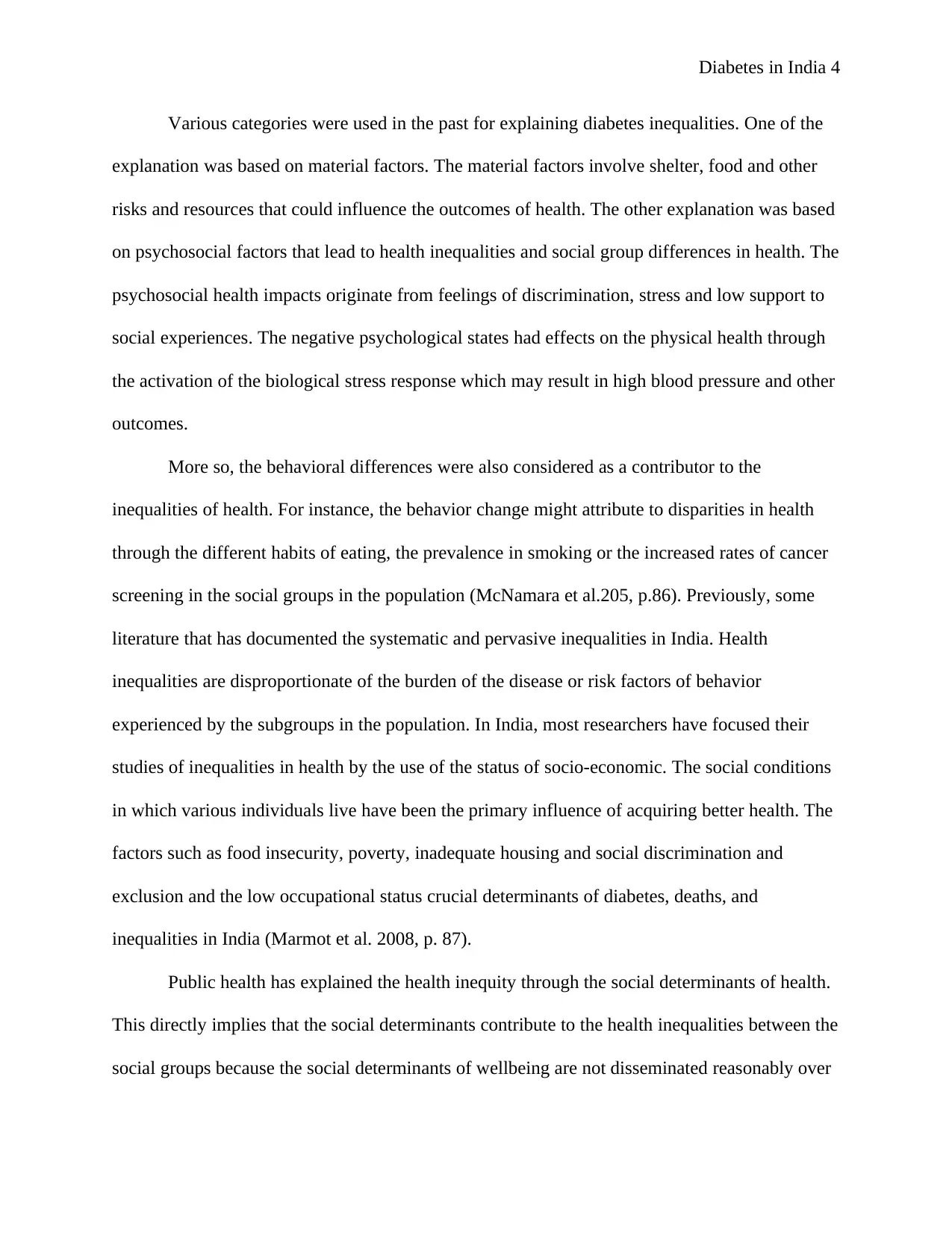
Diabetes in India 4
Various categories were used in the past for explaining diabetes inequalities. One of the
explanation was based on material factors. The material factors involve shelter, food and other
risks and resources that could influence the outcomes of health. The other explanation was based
on psychosocial factors that lead to health inequalities and social group differences in health. The
psychosocial health impacts originate from feelings of discrimination, stress and low support to
social experiences. The negative psychological states had effects on the physical health through
the activation of the biological stress response which may result in high blood pressure and other
outcomes.
More so, the behavioral differences were also considered as a contributor to the
inequalities of health. For instance, the behavior change might attribute to disparities in health
through the different habits of eating, the prevalence in smoking or the increased rates of cancer
screening in the social groups in the population (McNamara et al.205, p.86). Previously, some
literature that has documented the systematic and pervasive inequalities in India. Health
inequalities are disproportionate of the burden of the disease or risk factors of behavior
experienced by the subgroups in the population. In India, most researchers have focused their
studies of inequalities in health by the use of the status of socio-economic. The social conditions
in which various individuals live have been the primary influence of acquiring better health. The
factors such as food insecurity, poverty, inadequate housing and social discrimination and
exclusion and the low occupational status crucial determinants of diabetes, deaths, and
inequalities in India (Marmot et al. 2008, p. 87).
Public health has explained the health inequity through the social determinants of health.
This directly implies that the social determinants contribute to the health inequalities between the
social groups because the social determinants of wellbeing are not disseminated reasonably over
Various categories were used in the past for explaining diabetes inequalities. One of the
explanation was based on material factors. The material factors involve shelter, food and other
risks and resources that could influence the outcomes of health. The other explanation was based
on psychosocial factors that lead to health inequalities and social group differences in health. The
psychosocial health impacts originate from feelings of discrimination, stress and low support to
social experiences. The negative psychological states had effects on the physical health through
the activation of the biological stress response which may result in high blood pressure and other
outcomes.
More so, the behavioral differences were also considered as a contributor to the
inequalities of health. For instance, the behavior change might attribute to disparities in health
through the different habits of eating, the prevalence in smoking or the increased rates of cancer
screening in the social groups in the population (McNamara et al.205, p.86). Previously, some
literature that has documented the systematic and pervasive inequalities in India. Health
inequalities are disproportionate of the burden of the disease or risk factors of behavior
experienced by the subgroups in the population. In India, most researchers have focused their
studies of inequalities in health by the use of the status of socio-economic. The social conditions
in which various individuals live have been the primary influence of acquiring better health. The
factors such as food insecurity, poverty, inadequate housing and social discrimination and
exclusion and the low occupational status crucial determinants of diabetes, deaths, and
inequalities in India (Marmot et al. 2008, p. 87).
Public health has explained the health inequity through the social determinants of health.
This directly implies that the social determinants contribute to the health inequalities between the
social groups because the social determinants of wellbeing are not disseminated reasonably over
Paraphrase This Document
Need a fresh take? Get an instant paraphrase of this document with our AI Paraphraser
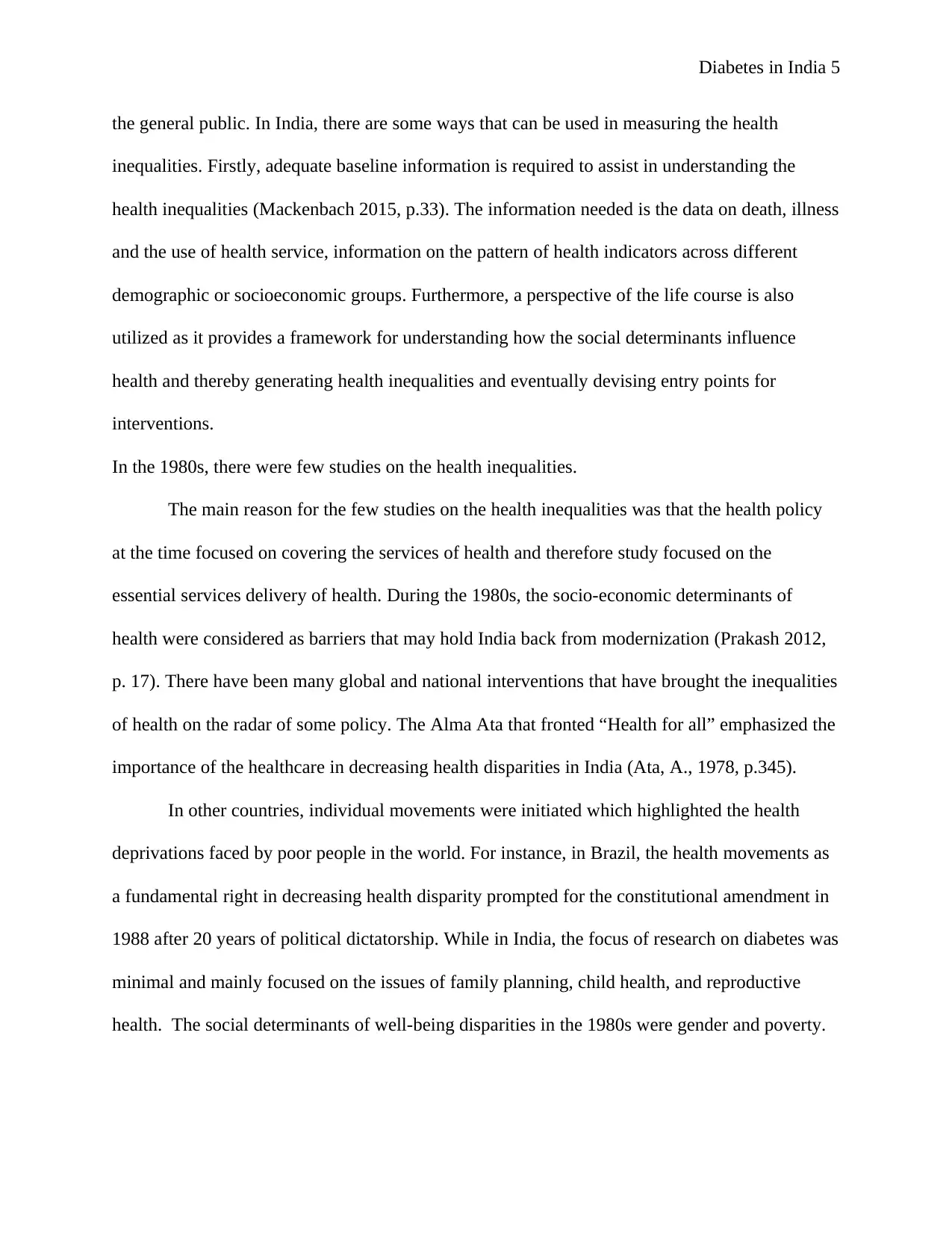
Diabetes in India 5
the general public. In India, there are some ways that can be used in measuring the health
inequalities. Firstly, adequate baseline information is required to assist in understanding the
health inequalities (Mackenbach 2015, p.33). The information needed is the data on death, illness
and the use of health service, information on the pattern of health indicators across different
demographic or socioeconomic groups. Furthermore, a perspective of the life course is also
utilized as it provides a framework for understanding how the social determinants influence
health and thereby generating health inequalities and eventually devising entry points for
interventions.
In the 1980s, there were few studies on the health inequalities.
The main reason for the few studies on the health inequalities was that the health policy
at the time focused on covering the services of health and therefore study focused on the
essential services delivery of health. During the 1980s, the socio-economic determinants of
health were considered as barriers that may hold India back from modernization (Prakash 2012,
p. 17). There have been many global and national interventions that have brought the inequalities
of health on the radar of some policy. The Alma Ata that fronted “Health for all” emphasized the
importance of the healthcare in decreasing health disparities in India (Ata, A., 1978, p.345).
In other countries, individual movements were initiated which highlighted the health
deprivations faced by poor people in the world. For instance, in Brazil, the health movements as
a fundamental right in decreasing health disparity prompted for the constitutional amendment in
1988 after 20 years of political dictatorship. While in India, the focus of research on diabetes was
minimal and mainly focused on the issues of family planning, child health, and reproductive
health. The social determinants of well-being disparities in the 1980s were gender and poverty.
the general public. In India, there are some ways that can be used in measuring the health
inequalities. Firstly, adequate baseline information is required to assist in understanding the
health inequalities (Mackenbach 2015, p.33). The information needed is the data on death, illness
and the use of health service, information on the pattern of health indicators across different
demographic or socioeconomic groups. Furthermore, a perspective of the life course is also
utilized as it provides a framework for understanding how the social determinants influence
health and thereby generating health inequalities and eventually devising entry points for
interventions.
In the 1980s, there were few studies on the health inequalities.
The main reason for the few studies on the health inequalities was that the health policy
at the time focused on covering the services of health and therefore study focused on the
essential services delivery of health. During the 1980s, the socio-economic determinants of
health were considered as barriers that may hold India back from modernization (Prakash 2012,
p. 17). There have been many global and national interventions that have brought the inequalities
of health on the radar of some policy. The Alma Ata that fronted “Health for all” emphasized the
importance of the healthcare in decreasing health disparities in India (Ata, A., 1978, p.345).
In other countries, individual movements were initiated which highlighted the health
deprivations faced by poor people in the world. For instance, in Brazil, the health movements as
a fundamental right in decreasing health disparity prompted for the constitutional amendment in
1988 after 20 years of political dictatorship. While in India, the focus of research on diabetes was
minimal and mainly focused on the issues of family planning, child health, and reproductive
health. The social determinants of well-being disparities in the 1980s were gender and poverty.
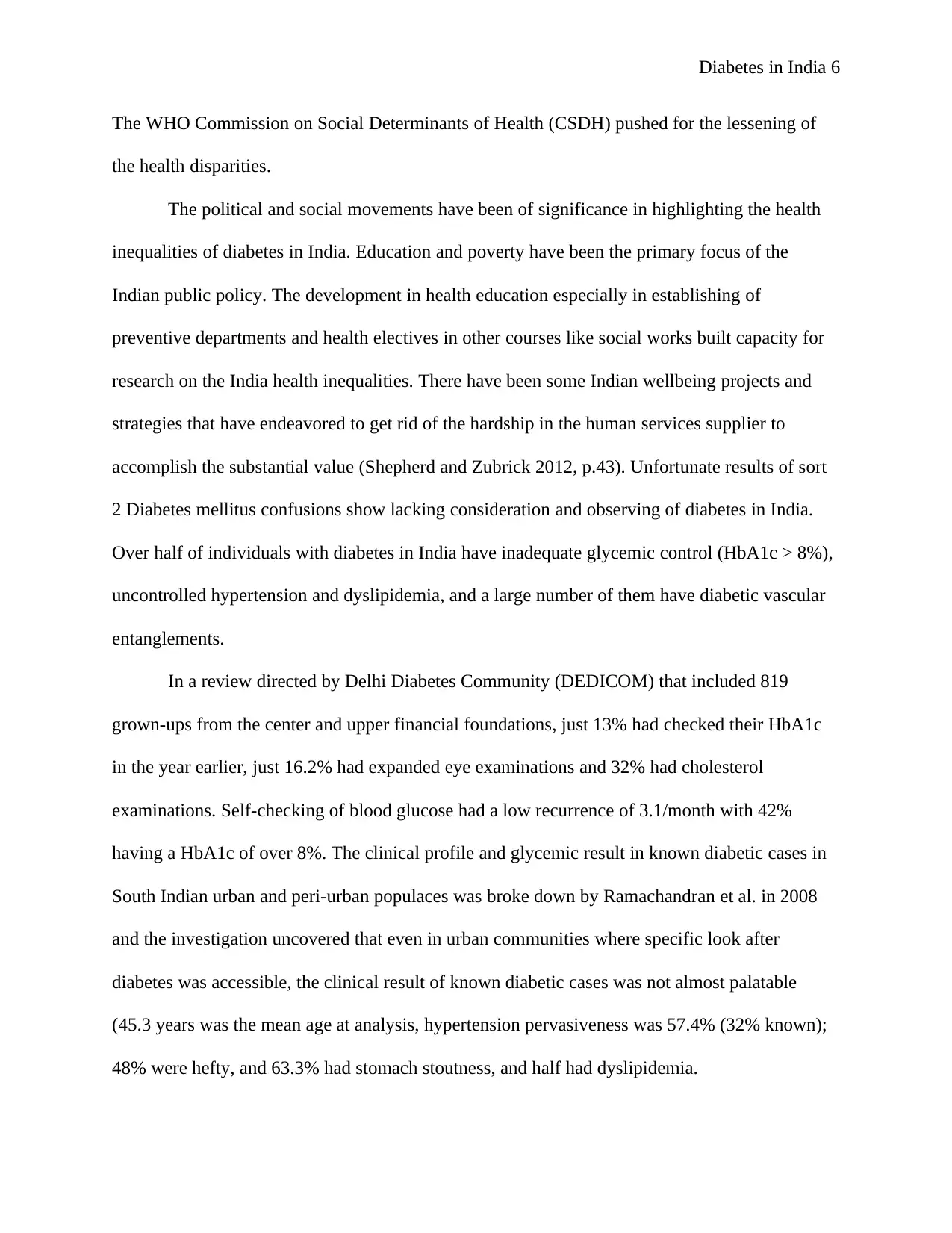
Diabetes in India 6
The WHO Commission on Social Determinants of Health (CSDH) pushed for the lessening of
the health disparities.
The political and social movements have been of significance in highlighting the health
inequalities of diabetes in India. Education and poverty have been the primary focus of the
Indian public policy. The development in health education especially in establishing of
preventive departments and health electives in other courses like social works built capacity for
research on the India health inequalities. There have been some Indian wellbeing projects and
strategies that have endeavored to get rid of the hardship in the human services supplier to
accomplish the substantial value (Shepherd and Zubrick 2012, p.43). Unfortunate results of sort
2 Diabetes mellitus confusions show lacking consideration and observing of diabetes in India.
Over half of individuals with diabetes in India have inadequate glycemic control (HbA1c > 8%),
uncontrolled hypertension and dyslipidemia, and a large number of them have diabetic vascular
entanglements.
In a review directed by Delhi Diabetes Community (DEDICOM) that included 819
grown-ups from the center and upper financial foundations, just 13% had checked their HbA1c
in the year earlier, just 16.2% had expanded eye examinations and 32% had cholesterol
examinations. Self-checking of blood glucose had a low recurrence of 3.1/month with 42%
having a HbA1c of over 8%. The clinical profile and glycemic result in known diabetic cases in
South Indian urban and peri-urban populaces was broke down by Ramachandran et al. in 2008
and the investigation uncovered that even in urban communities where specific look after
diabetes was accessible, the clinical result of known diabetic cases was not almost palatable
(45.3 years was the mean age at analysis, hypertension pervasiveness was 57.4% (32% known);
48% were hefty, and 63.3% had stomach stoutness, and half had dyslipidemia.
The WHO Commission on Social Determinants of Health (CSDH) pushed for the lessening of
the health disparities.
The political and social movements have been of significance in highlighting the health
inequalities of diabetes in India. Education and poverty have been the primary focus of the
Indian public policy. The development in health education especially in establishing of
preventive departments and health electives in other courses like social works built capacity for
research on the India health inequalities. There have been some Indian wellbeing projects and
strategies that have endeavored to get rid of the hardship in the human services supplier to
accomplish the substantial value (Shepherd and Zubrick 2012, p.43). Unfortunate results of sort
2 Diabetes mellitus confusions show lacking consideration and observing of diabetes in India.
Over half of individuals with diabetes in India have inadequate glycemic control (HbA1c > 8%),
uncontrolled hypertension and dyslipidemia, and a large number of them have diabetic vascular
entanglements.
In a review directed by Delhi Diabetes Community (DEDICOM) that included 819
grown-ups from the center and upper financial foundations, just 13% had checked their HbA1c
in the year earlier, just 16.2% had expanded eye examinations and 32% had cholesterol
examinations. Self-checking of blood glucose had a low recurrence of 3.1/month with 42%
having a HbA1c of over 8%. The clinical profile and glycemic result in known diabetic cases in
South Indian urban and peri-urban populaces was broke down by Ramachandran et al. in 2008
and the investigation uncovered that even in urban communities where specific look after
diabetes was accessible, the clinical result of known diabetic cases was not almost palatable
(45.3 years was the mean age at analysis, hypertension pervasiveness was 57.4% (32% known);
48% were hefty, and 63.3% had stomach stoutness, and half had dyslipidemia.
⊘ This is a preview!⊘
Do you want full access?
Subscribe today to unlock all pages.

Trusted by 1+ million students worldwide
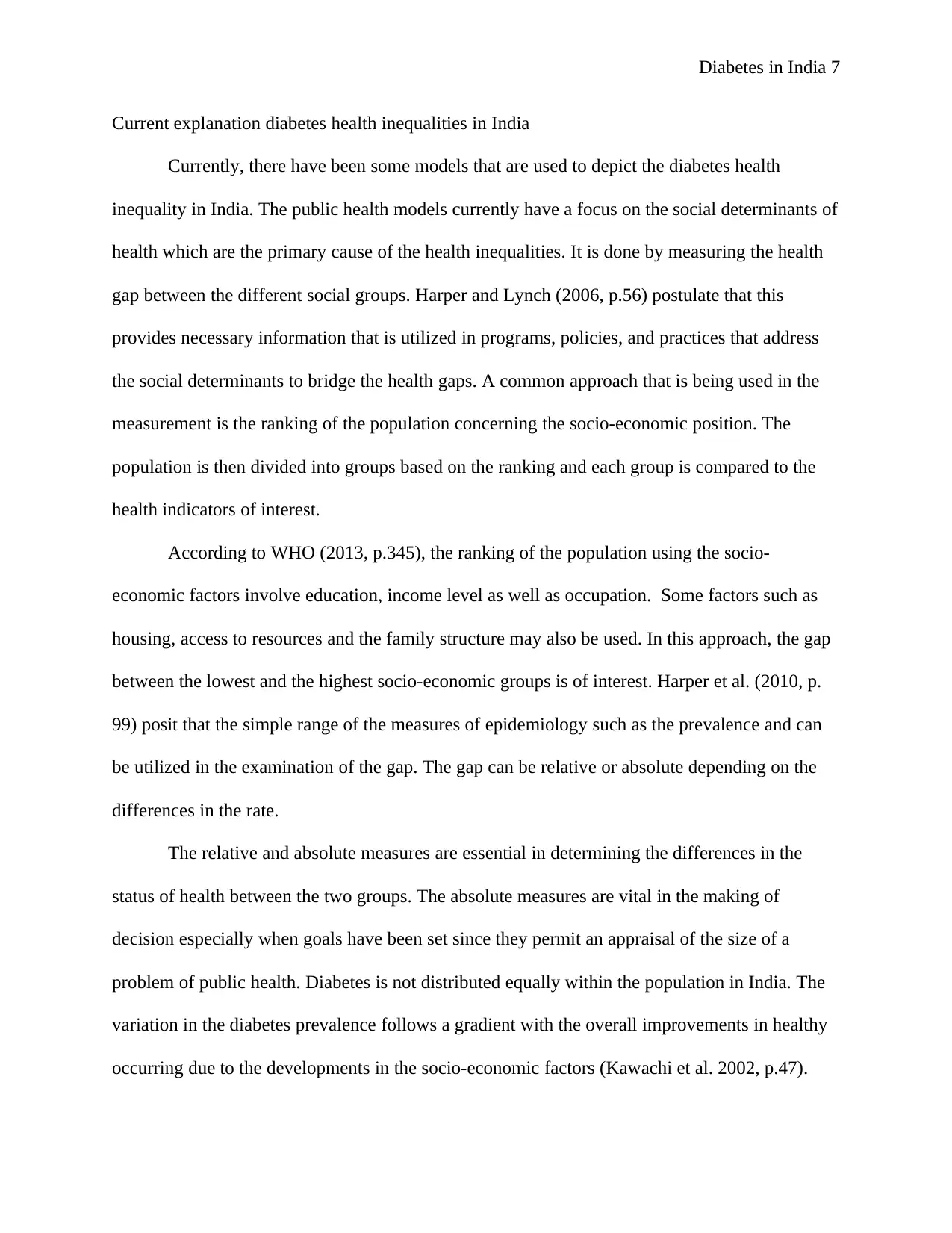
Diabetes in India 7
Current explanation diabetes health inequalities in India
Currently, there have been some models that are used to depict the diabetes health
inequality in India. The public health models currently have a focus on the social determinants of
health which are the primary cause of the health inequalities. It is done by measuring the health
gap between the different social groups. Harper and Lynch (2006, p.56) postulate that this
provides necessary information that is utilized in programs, policies, and practices that address
the social determinants to bridge the health gaps. A common approach that is being used in the
measurement is the ranking of the population concerning the socio-economic position. The
population is then divided into groups based on the ranking and each group is compared to the
health indicators of interest.
According to WHO (2013, p.345), the ranking of the population using the socio-
economic factors involve education, income level as well as occupation. Some factors such as
housing, access to resources and the family structure may also be used. In this approach, the gap
between the lowest and the highest socio-economic groups is of interest. Harper et al. (2010, p.
99) posit that the simple range of the measures of epidemiology such as the prevalence and can
be utilized in the examination of the gap. The gap can be relative or absolute depending on the
differences in the rate.
The relative and absolute measures are essential in determining the differences in the
status of health between the two groups. The absolute measures are vital in the making of
decision especially when goals have been set since they permit an appraisal of the size of a
problem of public health. Diabetes is not distributed equally within the population in India. The
variation in the diabetes prevalence follows a gradient with the overall improvements in healthy
occurring due to the developments in the socio-economic factors (Kawachi et al. 2002, p.47).
Current explanation diabetes health inequalities in India
Currently, there have been some models that are used to depict the diabetes health
inequality in India. The public health models currently have a focus on the social determinants of
health which are the primary cause of the health inequalities. It is done by measuring the health
gap between the different social groups. Harper and Lynch (2006, p.56) postulate that this
provides necessary information that is utilized in programs, policies, and practices that address
the social determinants to bridge the health gaps. A common approach that is being used in the
measurement is the ranking of the population concerning the socio-economic position. The
population is then divided into groups based on the ranking and each group is compared to the
health indicators of interest.
According to WHO (2013, p.345), the ranking of the population using the socio-
economic factors involve education, income level as well as occupation. Some factors such as
housing, access to resources and the family structure may also be used. In this approach, the gap
between the lowest and the highest socio-economic groups is of interest. Harper et al. (2010, p.
99) posit that the simple range of the measures of epidemiology such as the prevalence and can
be utilized in the examination of the gap. The gap can be relative or absolute depending on the
differences in the rate.
The relative and absolute measures are essential in determining the differences in the
status of health between the two groups. The absolute measures are vital in the making of
decision especially when goals have been set since they permit an appraisal of the size of a
problem of public health. Diabetes is not distributed equally within the population in India. The
variation in the diabetes prevalence follows a gradient with the overall improvements in healthy
occurring due to the developments in the socio-economic factors (Kawachi et al. 2002, p.47).
Paraphrase This Document
Need a fresh take? Get an instant paraphrase of this document with our AI Paraphraser
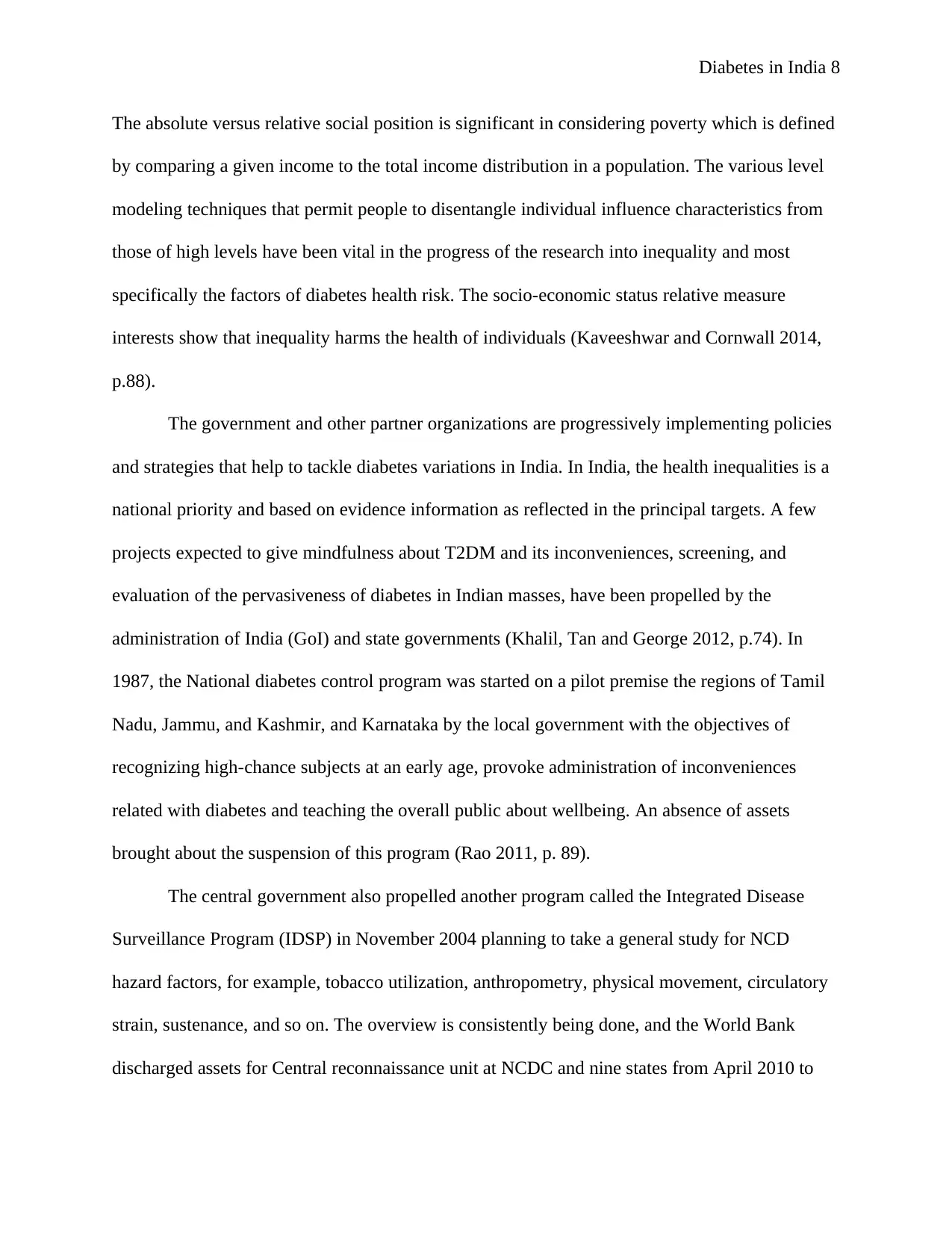
Diabetes in India 8
The absolute versus relative social position is significant in considering poverty which is defined
by comparing a given income to the total income distribution in a population. The various level
modeling techniques that permit people to disentangle individual influence characteristics from
those of high levels have been vital in the progress of the research into inequality and most
specifically the factors of diabetes health risk. The socio-economic status relative measure
interests show that inequality harms the health of individuals (Kaveeshwar and Cornwall 2014,
p.88).
The government and other partner organizations are progressively implementing policies
and strategies that help to tackle diabetes variations in India. In India, the health inequalities is a
national priority and based on evidence information as reflected in the principal targets. A few
projects expected to give mindfulness about T2DM and its inconveniences, screening, and
evaluation of the pervasiveness of diabetes in Indian masses, have been propelled by the
administration of India (GoI) and state governments (Khalil, Tan and George 2012, p.74). In
1987, the National diabetes control program was started on a pilot premise the regions of Tamil
Nadu, Jammu, and Kashmir, and Karnataka by the local government with the objectives of
recognizing high-chance subjects at an early age, provoke administration of inconveniences
related with diabetes and teaching the overall public about wellbeing. An absence of assets
brought about the suspension of this program (Rao 2011, p. 89).
The central government also propelled another program called the Integrated Disease
Surveillance Program (IDSP) in November 2004 planning to take a general study for NCD
hazard factors, for example, tobacco utilization, anthropometry, physical movement, circulatory
strain, sustenance, and so on. The overview is consistently being done, and the World Bank
discharged assets for Central reconnaissance unit at NCDC and nine states from April 2010 to
The absolute versus relative social position is significant in considering poverty which is defined
by comparing a given income to the total income distribution in a population. The various level
modeling techniques that permit people to disentangle individual influence characteristics from
those of high levels have been vital in the progress of the research into inequality and most
specifically the factors of diabetes health risk. The socio-economic status relative measure
interests show that inequality harms the health of individuals (Kaveeshwar and Cornwall 2014,
p.88).
The government and other partner organizations are progressively implementing policies
and strategies that help to tackle diabetes variations in India. In India, the health inequalities is a
national priority and based on evidence information as reflected in the principal targets. A few
projects expected to give mindfulness about T2DM and its inconveniences, screening, and
evaluation of the pervasiveness of diabetes in Indian masses, have been propelled by the
administration of India (GoI) and state governments (Khalil, Tan and George 2012, p.74). In
1987, the National diabetes control program was started on a pilot premise the regions of Tamil
Nadu, Jammu, and Kashmir, and Karnataka by the local government with the objectives of
recognizing high-chance subjects at an early age, provoke administration of inconveniences
related with diabetes and teaching the overall public about wellbeing. An absence of assets
brought about the suspension of this program (Rao 2011, p. 89).
The central government also propelled another program called the Integrated Disease
Surveillance Program (IDSP) in November 2004 planning to take a general study for NCD
hazard factors, for example, tobacco utilization, anthropometry, physical movement, circulatory
strain, sustenance, and so on. The overview is consistently being done, and the World Bank
discharged assets for Central reconnaissance unit at NCDC and nine states from April 2010 to
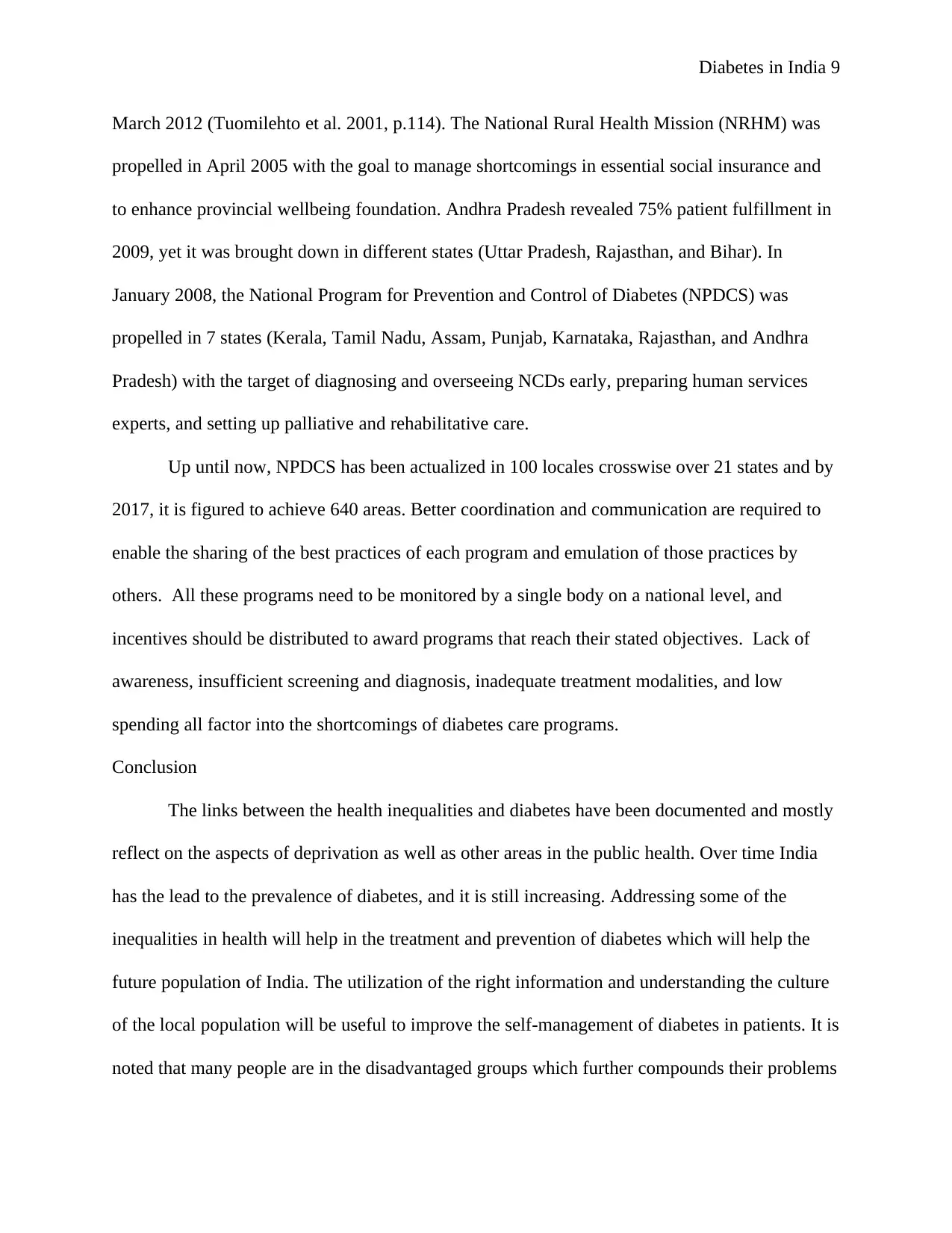
Diabetes in India 9
March 2012 (Tuomilehto et al. 2001, p.114). The National Rural Health Mission (NRHM) was
propelled in April 2005 with the goal to manage shortcomings in essential social insurance and
to enhance provincial wellbeing foundation. Andhra Pradesh revealed 75% patient fulfillment in
2009, yet it was brought down in different states (Uttar Pradesh, Rajasthan, and Bihar). In
January 2008, the National Program for Prevention and Control of Diabetes (NPDCS) was
propelled in 7 states (Kerala, Tamil Nadu, Assam, Punjab, Karnataka, Rajasthan, and Andhra
Pradesh) with the target of diagnosing and overseeing NCDs early, preparing human services
experts, and setting up palliative and rehabilitative care.
Up until now, NPDCS has been actualized in 100 locales crosswise over 21 states and by
2017, it is figured to achieve 640 areas. Better coordination and communication are required to
enable the sharing of the best practices of each program and emulation of those practices by
others. All these programs need to be monitored by a single body on a national level, and
incentives should be distributed to award programs that reach their stated objectives. Lack of
awareness, insufficient screening and diagnosis, inadequate treatment modalities, and low
spending all factor into the shortcomings of diabetes care programs.
Conclusion
The links between the health inequalities and diabetes have been documented and mostly
reflect on the aspects of deprivation as well as other areas in the public health. Over time India
has the lead to the prevalence of diabetes, and it is still increasing. Addressing some of the
inequalities in health will help in the treatment and prevention of diabetes which will help the
future population of India. The utilization of the right information and understanding the culture
of the local population will be useful to improve the self-management of diabetes in patients. It is
noted that many people are in the disadvantaged groups which further compounds their problems
March 2012 (Tuomilehto et al. 2001, p.114). The National Rural Health Mission (NRHM) was
propelled in April 2005 with the goal to manage shortcomings in essential social insurance and
to enhance provincial wellbeing foundation. Andhra Pradesh revealed 75% patient fulfillment in
2009, yet it was brought down in different states (Uttar Pradesh, Rajasthan, and Bihar). In
January 2008, the National Program for Prevention and Control of Diabetes (NPDCS) was
propelled in 7 states (Kerala, Tamil Nadu, Assam, Punjab, Karnataka, Rajasthan, and Andhra
Pradesh) with the target of diagnosing and overseeing NCDs early, preparing human services
experts, and setting up palliative and rehabilitative care.
Up until now, NPDCS has been actualized in 100 locales crosswise over 21 states and by
2017, it is figured to achieve 640 areas. Better coordination and communication are required to
enable the sharing of the best practices of each program and emulation of those practices by
others. All these programs need to be monitored by a single body on a national level, and
incentives should be distributed to award programs that reach their stated objectives. Lack of
awareness, insufficient screening and diagnosis, inadequate treatment modalities, and low
spending all factor into the shortcomings of diabetes care programs.
Conclusion
The links between the health inequalities and diabetes have been documented and mostly
reflect on the aspects of deprivation as well as other areas in the public health. Over time India
has the lead to the prevalence of diabetes, and it is still increasing. Addressing some of the
inequalities in health will help in the treatment and prevention of diabetes which will help the
future population of India. The utilization of the right information and understanding the culture
of the local population will be useful to improve the self-management of diabetes in patients. It is
noted that many people are in the disadvantaged groups which further compounds their problems
⊘ This is a preview!⊘
Do you want full access?
Subscribe today to unlock all pages.

Trusted by 1+ million students worldwide
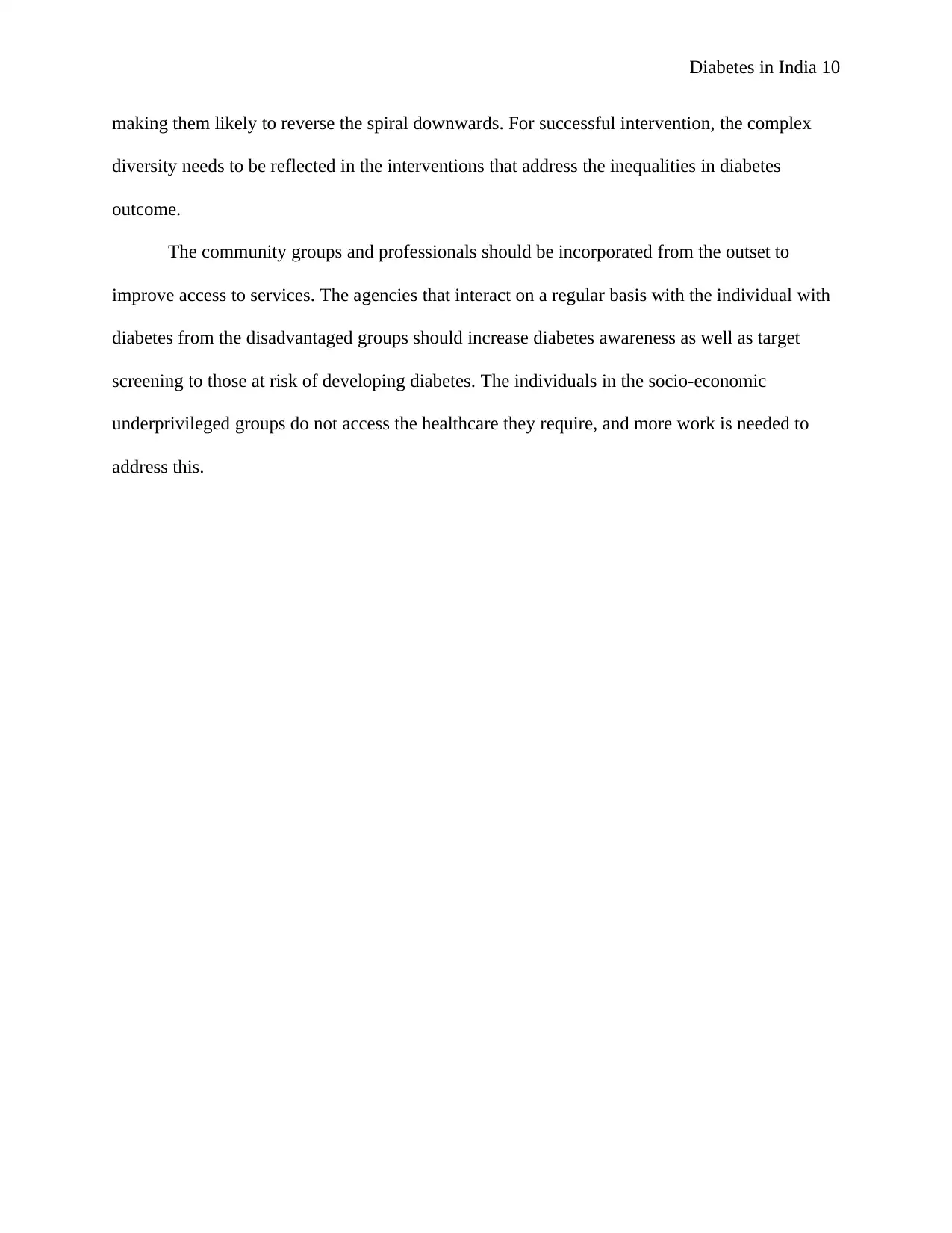
Diabetes in India 10
making them likely to reverse the spiral downwards. For successful intervention, the complex
diversity needs to be reflected in the interventions that address the inequalities in diabetes
outcome.
The community groups and professionals should be incorporated from the outset to
improve access to services. The agencies that interact on a regular basis with the individual with
diabetes from the disadvantaged groups should increase diabetes awareness as well as target
screening to those at risk of developing diabetes. The individuals in the socio-economic
underprivileged groups do not access the healthcare they require, and more work is needed to
address this.
making them likely to reverse the spiral downwards. For successful intervention, the complex
diversity needs to be reflected in the interventions that address the inequalities in diabetes
outcome.
The community groups and professionals should be incorporated from the outset to
improve access to services. The agencies that interact on a regular basis with the individual with
diabetes from the disadvantaged groups should increase diabetes awareness as well as target
screening to those at risk of developing diabetes. The individuals in the socio-economic
underprivileged groups do not access the healthcare they require, and more work is needed to
address this.
Paraphrase This Document
Need a fresh take? Get an instant paraphrase of this document with our AI Paraphraser
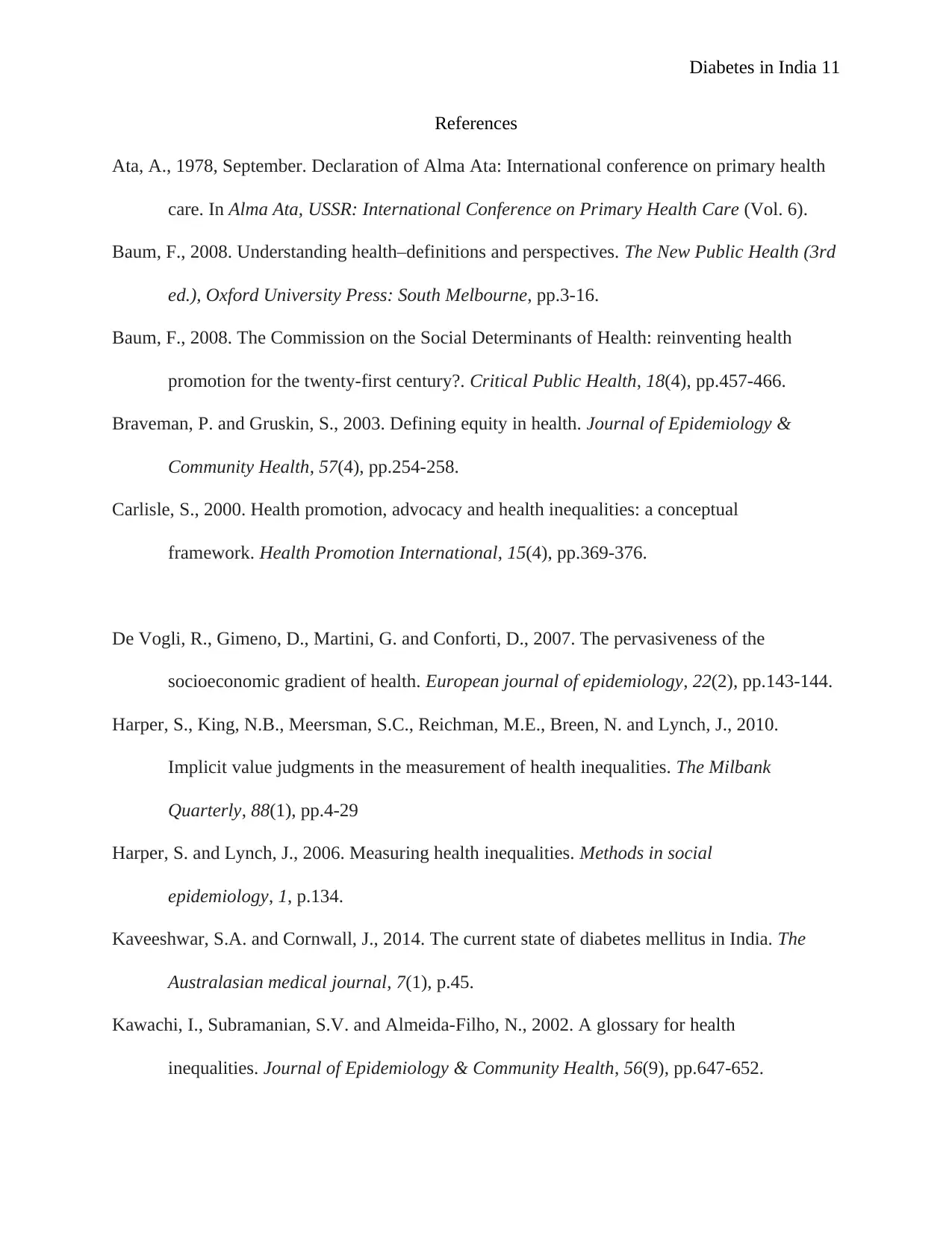
Diabetes in India 11
References
Ata, A., 1978, September. Declaration of Alma Ata: International conference on primary health
care. In Alma Ata, USSR: International Conference on Primary Health Care (Vol. 6).
Baum, F., 2008. Understanding health–definitions and perspectives. The New Public Health (3rd
ed.), Oxford University Press: South Melbourne, pp.3-16.
Baum, F., 2008. The Commission on the Social Determinants of Health: reinventing health
promotion for the twenty-first century?. Critical Public Health, 18(4), pp.457-466.
Braveman, P. and Gruskin, S., 2003. Defining equity in health. Journal of Epidemiology &
Community Health, 57(4), pp.254-258.
Carlisle, S., 2000. Health promotion, advocacy and health inequalities: a conceptual
framework. Health Promotion International, 15(4), pp.369-376.
De Vogli, R., Gimeno, D., Martini, G. and Conforti, D., 2007. The pervasiveness of the
socioeconomic gradient of health. European journal of epidemiology, 22(2), pp.143-144.
Harper, S., King, N.B., Meersman, S.C., Reichman, M.E., Breen, N. and Lynch, J., 2010.
Implicit value judgments in the measurement of health inequalities. The Milbank
Quarterly, 88(1), pp.4-29
Harper, S. and Lynch, J., 2006. Measuring health inequalities. Methods in social
epidemiology, 1, p.134.
Kaveeshwar, S.A. and Cornwall, J., 2014. The current state of diabetes mellitus in India. The
Australasian medical journal, 7(1), p.45.
Kawachi, I., Subramanian, S.V. and Almeida-Filho, N., 2002. A glossary for health
inequalities. Journal of Epidemiology & Community Health, 56(9), pp.647-652.
References
Ata, A., 1978, September. Declaration of Alma Ata: International conference on primary health
care. In Alma Ata, USSR: International Conference on Primary Health Care (Vol. 6).
Baum, F., 2008. Understanding health–definitions and perspectives. The New Public Health (3rd
ed.), Oxford University Press: South Melbourne, pp.3-16.
Baum, F., 2008. The Commission on the Social Determinants of Health: reinventing health
promotion for the twenty-first century?. Critical Public Health, 18(4), pp.457-466.
Braveman, P. and Gruskin, S., 2003. Defining equity in health. Journal of Epidemiology &
Community Health, 57(4), pp.254-258.
Carlisle, S., 2000. Health promotion, advocacy and health inequalities: a conceptual
framework. Health Promotion International, 15(4), pp.369-376.
De Vogli, R., Gimeno, D., Martini, G. and Conforti, D., 2007. The pervasiveness of the
socioeconomic gradient of health. European journal of epidemiology, 22(2), pp.143-144.
Harper, S., King, N.B., Meersman, S.C., Reichman, M.E., Breen, N. and Lynch, J., 2010.
Implicit value judgments in the measurement of health inequalities. The Milbank
Quarterly, 88(1), pp.4-29
Harper, S. and Lynch, J., 2006. Measuring health inequalities. Methods in social
epidemiology, 1, p.134.
Kaveeshwar, S.A. and Cornwall, J., 2014. The current state of diabetes mellitus in India. The
Australasian medical journal, 7(1), p.45.
Kawachi, I., Subramanian, S.V. and Almeida-Filho, N., 2002. A glossary for health
inequalities. Journal of Epidemiology & Community Health, 56(9), pp.647-652.
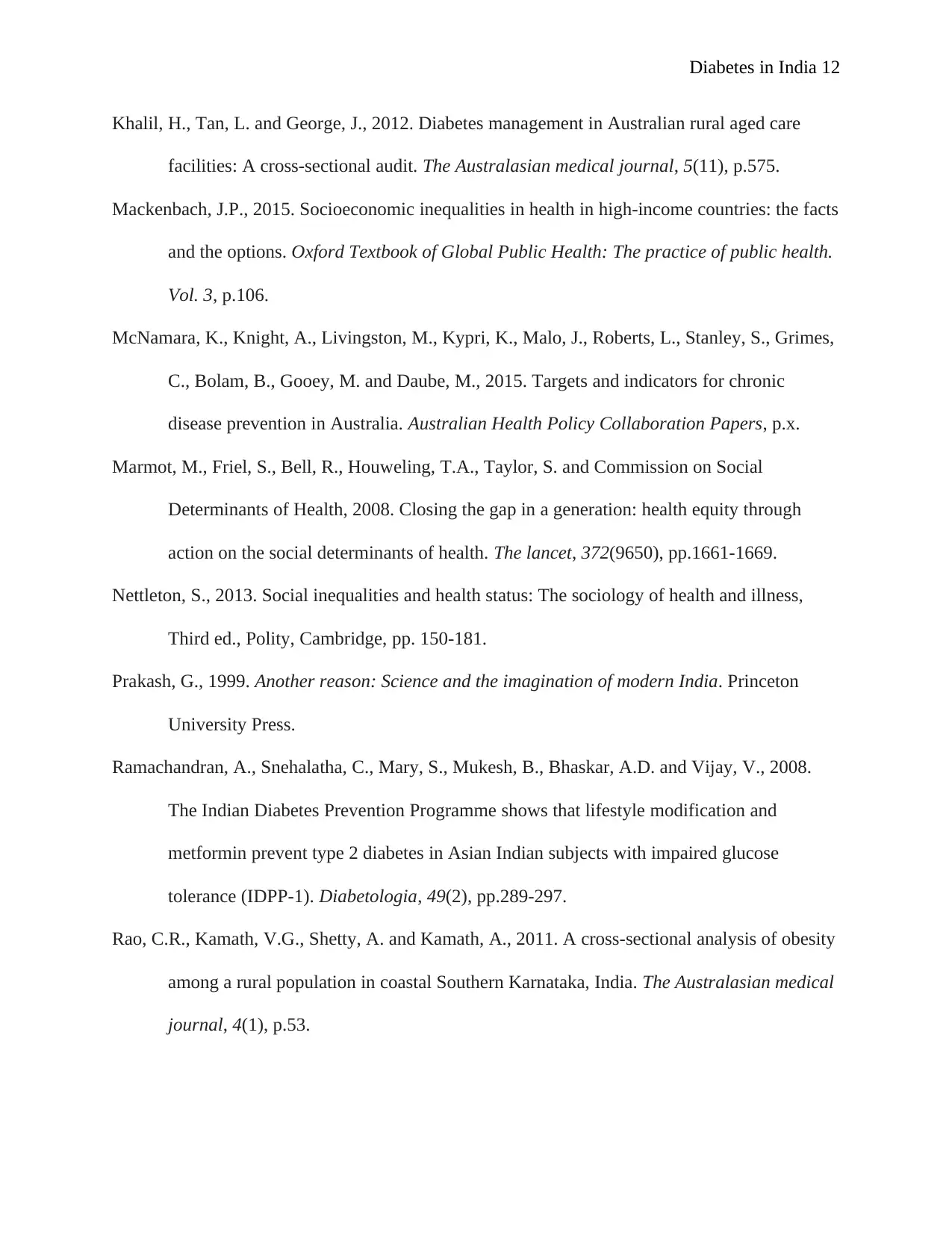
Diabetes in India 12
Khalil, H., Tan, L. and George, J., 2012. Diabetes management in Australian rural aged care
facilities: A cross-sectional audit. The Australasian medical journal, 5(11), p.575.
Mackenbach, J.P., 2015. Socioeconomic inequalities in health in high-income countries: the facts
and the options. Oxford Textbook of Global Public Health: The practice of public health.
Vol. 3, p.106.
McNamara, K., Knight, A., Livingston, M., Kypri, K., Malo, J., Roberts, L., Stanley, S., Grimes,
C., Bolam, B., Gooey, M. and Daube, M., 2015. Targets and indicators for chronic
disease prevention in Australia. Australian Health Policy Collaboration Papers, p.x.
Marmot, M., Friel, S., Bell, R., Houweling, T.A., Taylor, S. and Commission on Social
Determinants of Health, 2008. Closing the gap in a generation: health equity through
action on the social determinants of health. The lancet, 372(9650), pp.1661-1669.
Nettleton, S., 2013. Social inequalities and health status: The sociology of health and illness,
Third ed., Polity, Cambridge, pp. 150-181.
Prakash, G., 1999. Another reason: Science and the imagination of modern India. Princeton
University Press.
Ramachandran, A., Snehalatha, C., Mary, S., Mukesh, B., Bhaskar, A.D. and Vijay, V., 2008.
The Indian Diabetes Prevention Programme shows that lifestyle modification and
metformin prevent type 2 diabetes in Asian Indian subjects with impaired glucose
tolerance (IDPP-1). Diabetologia, 49(2), pp.289-297.
Rao, C.R., Kamath, V.G., Shetty, A. and Kamath, A., 2011. A cross-sectional analysis of obesity
among a rural population in coastal Southern Karnataka, India. The Australasian medical
journal, 4(1), p.53.
Khalil, H., Tan, L. and George, J., 2012. Diabetes management in Australian rural aged care
facilities: A cross-sectional audit. The Australasian medical journal, 5(11), p.575.
Mackenbach, J.P., 2015. Socioeconomic inequalities in health in high-income countries: the facts
and the options. Oxford Textbook of Global Public Health: The practice of public health.
Vol. 3, p.106.
McNamara, K., Knight, A., Livingston, M., Kypri, K., Malo, J., Roberts, L., Stanley, S., Grimes,
C., Bolam, B., Gooey, M. and Daube, M., 2015. Targets and indicators for chronic
disease prevention in Australia. Australian Health Policy Collaboration Papers, p.x.
Marmot, M., Friel, S., Bell, R., Houweling, T.A., Taylor, S. and Commission on Social
Determinants of Health, 2008. Closing the gap in a generation: health equity through
action on the social determinants of health. The lancet, 372(9650), pp.1661-1669.
Nettleton, S., 2013. Social inequalities and health status: The sociology of health and illness,
Third ed., Polity, Cambridge, pp. 150-181.
Prakash, G., 1999. Another reason: Science and the imagination of modern India. Princeton
University Press.
Ramachandran, A., Snehalatha, C., Mary, S., Mukesh, B., Bhaskar, A.D. and Vijay, V., 2008.
The Indian Diabetes Prevention Programme shows that lifestyle modification and
metformin prevent type 2 diabetes in Asian Indian subjects with impaired glucose
tolerance (IDPP-1). Diabetologia, 49(2), pp.289-297.
Rao, C.R., Kamath, V.G., Shetty, A. and Kamath, A., 2011. A cross-sectional analysis of obesity
among a rural population in coastal Southern Karnataka, India. The Australasian medical
journal, 4(1), p.53.
⊘ This is a preview!⊘
Do you want full access?
Subscribe today to unlock all pages.

Trusted by 1+ million students worldwide
1 out of 13
Related Documents
Your All-in-One AI-Powered Toolkit for Academic Success.
+13062052269
info@desklib.com
Available 24*7 on WhatsApp / Email
![[object Object]](/_next/static/media/star-bottom.7253800d.svg)
Unlock your academic potential
Copyright © 2020–2025 A2Z Services. All Rights Reserved. Developed and managed by ZUCOL.





